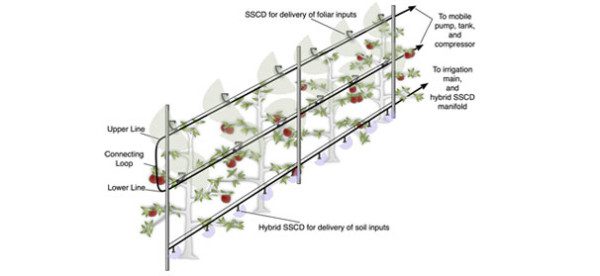

Dec 2, 2011Researchers working on orchard of the future
Imagine an apple or cherry orchard that can be fertilized, watered and sprayed for pests with the push of a button. Researchers have been imagining this for years, but now they are working to create a system that may be just that easy, said Matt Grieshop, an organic pest specialist with Michigan State University (MSU).
Grieshop is heading a team of researchers from across the country who are in the middle of a five-year plan to develop such an orchard system.
The idea is simple, and isn’t new, Grieshop said. The goal is to develop a system of orchard inputs that runs through pipes or hoses and can be turned on from the end of a row, from a spray shack or even remotely. These inputs could include water, fertilizer and pesticides, and the system would be more efficient with time, energy and costs – in theory. That last part is the sticking point, and the reason for the study’s longevity.
“Growers and researchers have always wanted to create some kind of system like we’re trying to do,” Grieshop said. “Now the technology exists to attempt to do this in a feasible manner.”
The technology is more than just nozzles and emitters, he said. Orchard technology has progressed, too. Gone are the days of orchards full of a few large trees. Modern orchards are trellised, high-density growing systems that are perfectly aligned with the development of this project.
The project has been broken into phases. For the first couple of years, the plan was to look into the system’s feasibility. The next step, Grieshop said, is to make such a system work for a commercial-sized orchard. What may work for a small-scale hobby grower with 1 acre may not work well for a commercial grower with 100 acres. The final stage will be to turn over the system to actual growers and get their feedback.
The technology has borrowed heavily from the greenhouse industry, Grieshop said. He referred to it as a “Frankenstein monster,” but in a good way. They took parts and elements from whatever sector they could to make the system work.
“One of the bigger challenges we’re running into is maintaining a constant pressure all the way across the line,” Grieshop said. “That, and we have to look at the materials we’re using to see how they react with the chemicals being applied. We have to ensure we come up with a robust system that is consistent across the whole system.”
Another challenge has been in the area of mating disruption, which is being tested by Larry Gut at MSU’s Trevor Nichols Research Complex in Fennville, Mich. Gut has been working with the system to dispense mating disruption scent for codling moth. They’ve had difficulties finding piping and hose materials that the scent won’t absorb into.
The benefits to a system like this are great, Grieshop said. The preliminary data the team has gathered from trials and testing has shown a reduction in drift and noise pollution, as well as better control of applications and reduced costs.
“We use blast sprayers to penetrate the canapy and deliver sprays,” he said. “But they also create drift, which has been a problem. Besides that, a large-scale sprayer isn’t really the most efficient delivery method for today’s modern orchard systems, which look more like vineyards than orchards.”
From a pest management strategy, this system makes even more sense, Grieshop said.
“Growers are having to rely on chemicals that are less forgiving to applications and timing,” he said. “This system can apply pesticides and fungicides in a matter of minutes, as opposed to hours. Growers will simply have to turn a valve or load a tube versus having to get out a tractor, mix and load a sprayer, get employees organized, etc. The systems will pay for themselves in time saving alone.”
That touches on another area Grieshop is excited about. There is the potential for significant labor savings with these new orchards management systems. It can also reduce the exposure of employees and growers to pesticides.
Over the next two years, the team of researchers will study how to put everything growers need into one system, Grieshop said. He has a feeling they will find an optimum scale of production that this system can fit into ideally. The challenge will be to adapt it from there.
“My prediction is that it will be the growers who will really make this system and technology work for them,” he said. “For it to be successful with them, it needs to be adaptive and yet still be repairable in the field by an average grower with duct tape and vise grips. Otherwise, it won’t be readily adopted on a large scale.”
By Derrek Sigler, Associate Editor














